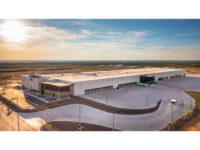Baking and food processing companies consider new projects every day. Some are new Greenfield development projects and others are expansions or  renovations to an existing facility. Either way, all projects come with concerns.
renovations to an existing facility. Either way, all projects come with concerns.
Here’s an outline of questions and answers commonly discussed when addressing design-build projects.
1. What do bakers need to know to run a successful large-scale project, such as a major project expansion to an existing bakery or a new Greenfield bakery development?
It is best if the baker has a clear idea of what they want to achieve with their project. The obvious will typically be production goals, but also goals regarding operational efficiencies, labor reductions, sustainability, automation, aesthetics, etc. It is also very helpful if the baker has a clear understanding of the budget and schedule requirements and expectations of their internal management.
2. What personnel resources should a baker plan to commit to the project?
Projects are typically more successful if the baking company appoints one individual that will serve as the point person for the project. At the very least, this will be someone that can facilitate information from the design and construction team to the bakery team, and at the most, a high-level manager or engineer that understands the process and communicates effectively.
3. How do bakers go about developing their projects most cost effectively, and what can they do to drive down the cost of their projects?
True project collaboration based on trust and openness with a qualified design and construction team is the best way for a baker to drive down costs on their projects. This level of collaboration allows for a sharing of ideas where cost, quality and facility performance can all be analyzed to determine the most efficient systems, methods and techniques to be utilized.
We also suggest that bakers allow for the competitive pricing process to be performed by the design-build team. A qualified design-build team will possess excellent skills and experience in the procurement of labor, materials and subcontractors related to the project, and they are well experienced to qualify and then quantify the procurement process to determine the best value.
Finally, a baker should engage all members of the project team (designers, equipment suppliers, vendors and construction) as early in the project as possible, even at the preliminary development phase. This allows the baker to receive a high skill and expertise level of decision making to occur before substantial dollars are expended.
4. What trends are you seeing, either within the baking industry or outside of it, that the baker should be aware of?
Energy, energy, energy. Every production and processing company, including baking companies, are interested in learning ways in which they can lower their energy costs and in the paybacks for various energy efficiency systems that are in the marketplace. This may include equipment modifications, sustainability systems and power generation systems.
Bakers and food processors are highly interested in hearing about and investing in new systems or equipment that can reduce their workforce numbers, including systems or equipment that can provide high levels of automation.
Expansions and renovations are where most of the work is occurring, and not in Greenfield development projects. Bakers continue to look for ways to maximize their existing facilities and increase production. They are also looking to existing facilities that are not presently being used for baking purposes today, but that can be renovated to accommodate growth needs in both production and storage.
Lastly, commodity and construction prices are rising rapidly. This is due to the labor shrinkage in the industry that occurred during the recession, and continues to occur due to the high amount of design and construction now occurring in the energy sectors. This construction labor shortage is expected to last for a number of years.
5. Describe for the baker your ideal client. What are their characteristics?
An ideal client is a company that has been successful in the baking industry, has a reputation for producing quality products and [maintains] a reputation for high integrity in working with its clients, vendors and suppliers. We are also excited about companies that have a commitment to continuous improvement within their processes, products and facilities.
6. When a baker first comes to you, what information do you want them to have available?
A baker should have a general idea of what they are trying to accomplish with their project. We can help them figure out the details and specifics, but they should have a good understanding of the goals they want to achieve, their budget constraints and their schedule requirements.
7. How involved does the baker need to be during construction?
Very little if they have chosen the right design and construction team. Our experience on our projects is that a baker should only need to dedicate approximately 1-2 days a month during the construction process. However, it is important that the baker have an individual that is very accessible during the construction process to answer questions as needed.
8. How involved does the baker need to be during process installation?
If the baker is managing the process installation, then they will need to be very involved. However, if the baker has selected A M King to provide and manage the process installation, then their involvement is greatly reduced to approximately one day per week. However, it is important that the baker be highly involved in the commissioning of the process equipment, regardless of who manages the installation. This includes their involvement in the commissioning of the controls systems for production and automation requirements, and typically a baker accepts the responsibility and accountability for this portion of the work.
9. Is government impacting construction and manufacturing projects?
Not extensively. The construction of privately held manufacturing projects continues to be mostly free of federal government interaction. However, the Federal Food Safety Modernization Act will continue to have impacts in regards to food processing facilities. On the state level, construction can be impacted depending on whether or not the project is being constructed in a Right To Work state. The usage of union labor will have an impact upon construction costs, sometimes upwards of a 30% increase. Manufacturing companies in general also need to be aware that additional conditions may be placed upon a project if that manufacturing company has accepted state- or local-funded economic incentives.
10. Are there any government incentives bakers should know about?
Absolutely. There are a number of economic incentives that are available to manufacturing companies. Almost all are tied to the creation of new jobs to a state or a community. Our company assists our clients regularly on obtaining these incentives, which may come in a variety of ways, including tax reductions, infrastructure additions or expansions, reduced or free land costs and free training, to name a few. There are also a number of incentives offered by utility companies, specifically electric power companies, if the manufacturer elects to add elements such as power generation and energy saving devices and equipment. Finally, incentives are also being offered to manufacturers for adding sustainability and conservation systems, including solar systems and other sustainability systems and equipment.
11. For a successful project, what one word would you want the bakers to take away from this information?
Partnership. For any project to realize its greatest success, there has to be a true partnership between the baker and its design and construction team. This partnership should have a strong element of trust, dependability, responsibility and integrity. When this occurs, projects are virtually guaranteed success.
Look for more of this and other design-build information and trends in Refrigerated & Frozen Foods’ Cold Storage Construction Guide (September 2015 issue).


